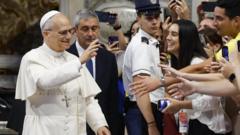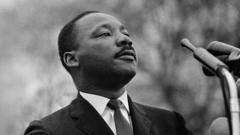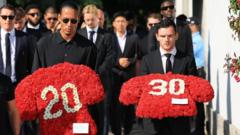The funeral for Pope Francis attracted tens of thousands, reflecting a life dedicated to service and inclusivity, despite a simpler ceremony compared to his predecessors.
Pope Francis: A Lasting Legacy and Farewell

Pope Francis: A Lasting Legacy and Farewell
Pope Francis, who passed away on April 21, 2025, leaves behind a transformative papacy marked by global outreach and humility.
As the sun rose on April 26, 2025, thousands filled St. Peter’s Square, ready to pay their respects to Pope Francis, the beloved leader who profoundly influenced the Catholic Church and engaged with diverse communities worldwide. His papacy, characterized by humility and outreach, commenced with an inaugural trip in 2013 to Lampedusa, emphasizing his commitment to migrants and social justice. Over the years, he traveled extensively, setting foot in troubled regions including Bolivia, Mosul, South Sudan, and parts of Asia and the Pacific.
In the months leading up to his passing, Pope Francis' health declined, confining him to the interiors of the Vatican and his guesthouse residence. Following his death, preparations began for an impactful funeral that aimed to celebrate his values rather than the grandeur typical of previous papacies. On April 26, a group of fourteen pallbearers carried his simple wooden coffin, adorned only with an open gospel, a stark contrast to the elaborate ceremonies of the past.
As mourners arrived in droves, the scene was one of heartfelt sadness and unity among the faithful. Clerics led prayers in multiple languages, and a choir sang psalms to honor the pontiff’s memory. The event, expected to draw tens of thousands, witnessed extensive security measures ensuring the safety of attendees during their time of mourning.
A private ceremony held the night before concluded with a bishop draping a white cloth over the pope's face before sealing the casket, symbolizing respect and reverence. Even with restrictive health conditions, Pope Francis had previously indicated preference for a less grand ceremony upon his passing. This modest approach mirrors his life’s ethos—focused on service, compassion, and solidarity with the vulnerable.
The bells of St. Peter's rang mournfully as the final farewells commenced, reflecting both the weight of loss and the hope inspired by his legacy of love and acceptance.
In the months leading up to his passing, Pope Francis' health declined, confining him to the interiors of the Vatican and his guesthouse residence. Following his death, preparations began for an impactful funeral that aimed to celebrate his values rather than the grandeur typical of previous papacies. On April 26, a group of fourteen pallbearers carried his simple wooden coffin, adorned only with an open gospel, a stark contrast to the elaborate ceremonies of the past.
As mourners arrived in droves, the scene was one of heartfelt sadness and unity among the faithful. Clerics led prayers in multiple languages, and a choir sang psalms to honor the pontiff’s memory. The event, expected to draw tens of thousands, witnessed extensive security measures ensuring the safety of attendees during their time of mourning.
A private ceremony held the night before concluded with a bishop draping a white cloth over the pope's face before sealing the casket, symbolizing respect and reverence. Even with restrictive health conditions, Pope Francis had previously indicated preference for a less grand ceremony upon his passing. This modest approach mirrors his life’s ethos—focused on service, compassion, and solidarity with the vulnerable.
The bells of St. Peter's rang mournfully as the final farewells commenced, reflecting both the weight of loss and the hope inspired by his legacy of love and acceptance.





















